
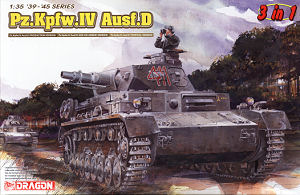
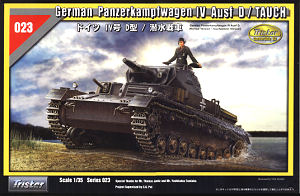
Panzer IV Ausf.D
Kit Comparison
Dragon Kit #6265 - Tristar Kit #35023
Part 1: Lower Hull and Running Gear
1:35th Scale
Kit Comparison by Terry Ashley
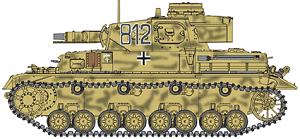
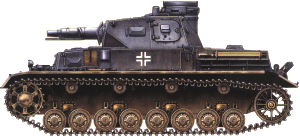





Dragon have followed Tristar once again with their release of the Panzer IV Ausf.D and one thing Dragon are very good at is the advertising spin that precedes each new kit release but does the kit live up to the hype? After the initial Panzer IV Aust.E (kit #6264) required over 40 corrections for the second Aust.E “Vorpanzer” (kit #6301) you would think Dragon would have ironed out most of the bugs but unfortunately not so with numerous minor and major dimensional errors still apparent in this Ausf.D kit.
The Tristar (TRI) kit also has some issues with the Dragon (DR) kit being more complex in a number of areas which does give some nice options and allows for some excellent detail to be included as does the Tristar kit with its own share of complexity in the parts breakdown but the number of issues in the Dragon Ausf.D has you scratching your head wondering what’s going on?
So let’s dive into the boxes and see what is on offer with the two kits and some may think what follows is simply nit picking, but the issues raised are there and it’s up to the individual to determine if these are worth considering or are happy to ignore them and just build the kits anyway.
All dimensions were checked against 1:35 plans in Panzer Tracks No.4 Panzer IV, the new Model Art Pz.Kpfw.IV Photo Book, Ground Power May 2003, Achtung Panzer No.3 Panzer IV and Koku Fan “World Tank Series” Panzer IV as well as details compared with the many excellent illustrations in the Achtung Panzer book and available period and museum reference photos plus other references listed below.
Lower Hull:
 Starting
from the ground up DR provides two lower hull tubs as with the previous Ausf.E
(kit #6264), one in initial configuration and the other with added side armour
panels for the up-armoured and Tropical versions with a separate front hull
section and separate rear hull panels. The only detail included on the hull
tub is the underside details except for the side suspension channels which
are separate parts, the side return roller mountings and the rear idler braces
plus the front final drive mounting plate details with all other parts added
separately.
Starting
from the ground up DR provides two lower hull tubs as with the previous Ausf.E
(kit #6264), one in initial configuration and the other with added side armour
panels for the up-armoured and Tropical versions with a separate front hull
section and separate rear hull panels. The only detail included on the hull
tub is the underside details except for the side suspension channels which
are separate parts, the side return roller mountings and the rear idler braces
plus the front final drive mounting plate details with all other parts added
separately.
The TRI kit has the initial configuration hull in three main parts with separate bottom and side panels with internal braces to help with assembly as well as separate rear hull panels and again the only detail included is the underside details, the side return roller mountings and the suspension bump stop mountings with all other parts added separately.
The underside panel detail is nicely represented on both kits except for
a strange square indentation in the middle of the DR hull instead of the
oval bolted panel as depicted on the TRI hull bottom. As mentioned the side
suspension channels and underside suspension mounting brackets are separate
parts on the DR hull and makes for fairly tedious assembly with the end result
not offering any more detail than in the TRI kit with the details moulded
onto the lower hull.
I guess that had to be done this way for better definition given the hulls
are complete tubs as opposed to the separate parts on the TRI hull.
There was an issue when fitting the separate DR suspension channels as each suspension mounting bracket had four raised pins on the side which can’t be seen after assembly and only hindered the placement of the suspension channels so it’s best to cut these off prior to assembly.
There are also 16 suspension housing bolts added to the TRI hull for added details with these being included with the separate suspension mounting brackets on the DR hull.
The three part TRI hull will require a bit of care when fitting together as the front and rear corner joins needed a little coaxing to fit tightly but ensuring the parts are held securely while the glue dries will eliminate any real problems and the fit of the lower side joins was good overall without the need for any filler.
The DR hull has separate left side fuel filler caps which can be glued open or closed with internal fuel pipe detail if you leave these open giving the option of a refuelling diorama while the TRI kit has these moulded closed with the hull side.
I have received a fair bit of information regarding the lower hull fillet DR part D71 and TRI part A13 and thanks to all those who have sent me photos and information on this.
From the information it is clear the configuration of the DR part D71 is correct (apart from being too narrow by about 1mm) in being the same thickness and having a slight downward curve at the outer edge and not wrong as I initially stated. There is an optical effect that gives the impression of a contour at he outer edge but having said that I am not convinced that all Panzer IV types had the same shaped fillet which means the TRI part A13 could also represent the fillet on some vehicles.
The available photos indicate that later G and J models all appear to have the even fillet but many earlier Ausf's also appear to have a larger contour at the outer edge. This is based on looking at the later photos where we know the DR configuration exists taking into account the optical effect, then looking at some earlier Ausf's where the contour appears far more pronounced taking into consideration the same optical effect. This could mean the bend is far more pronounced on some earlier models or the fillet does have some form of contour?
Having said all that it does mean the DR kit part is correct but doesn't necessarily mean the TRI part is incorrect and I'm still open for further input.
But if you wanted to alter the TRI part to the known configuration is it very simple because taking off some plastic is easier than adding it back on, so just trim the fillet to be the same thickness and add a slight downward bend at the outer edge that same as on the DR part.
The depth of the part is hard to determine as none of the plans show this area apart from the width and also the DR fillet is included with the rear underside hull panel while it is completely separate on the TRI kit which is simply a design issue but may look confusing in the images.
At the front are the towing shackles made up of four parts each on both kits with additional etched pin chain included with the DR kit.
The fit of the front panel on the DR kit was very good as was the fit of the rear hull panels on both kits to finish off the basic hull assembly with both hulls also measuring out well when compared to the plans and each other.
Rear Hull panels:
The rear hull assemblies are very busy on both kits with most of the details
being separate parts on both kits for good detail but there are some marked
differences between the two kits here.
Firstly the idler mountings have their mounting plate as part of the separate mounting on the DR kit while it is part of the rear hull on the TRI kit with the large idler tensioning assembly being in four separate parts on the DR kit and a single part with the TRI kit. This does allow for better detail definition on the DR part as well as including the four small notches on the bracket cap that are not on the TRI part.
The other big difference is the way the main exhaust/muffler is handled with the DR kit having three cylindrical sections and two end caps and the TRI kit having the muffler in two conventional halves with two end caps and just the usual join seam to be removed, an easy job due to the good fit of parts.
The main issue here is the DR muffler is undersized being about 2mm short and the muffler diameter slightly too narrow with the mounting brackets in the wrong location, in short you are left with the option of completely rebuilding the muffler or living with the undersized part.
The TRI muffler matched the sizes in the available 1:35 plans exactly in length and diameter as well as bracket location with the small lower exhaust pipes stubs also being undersized on the DR muffler.
The small auxiliary muffler on the DR kit is also too short by about 1.5mm but the end outlet pipe on the TRI muffler is about 2mm too long representing the earlier configuration but it’s easy to cut this off to the correct length but not so easy to fix the DR muffler sizes.
There are other smaller details you can add to both kits to enhance this area after referring to available references.
Moving to the upper rear hull plate there are a couple noticeable errors on the DR panel with the four mounting bolts at the middle of the panel being in the wrong location and too closely grouped but you can easily relocate these.
The other issue is the radiator fan access port cover which is moulded separately on the DR kit but is actually in the wrong location being about 1mm to the right of where it should be. Both these features are correct on the TRI panel although the radiator fan access port cover is moulded closed with the panel which isn’t a big deal.
Both kits include the early style smoke candle racks with the DR rack having two parts with five separate smoke candle that also include fine etched chains while the TRI rack has five parts for better detail with five separate smoke candles.
The rear mounted tow cable is provided in braided wire in both kits with plastic end shackles to allow for very natural bends and appearance.
Suspension/Final Drive Housings:
 It
should be noted that Tristar first issued there suspension set that included
the working suspension and separate rubber sections on the road wheels even
before releasing their first Panzer IV kit and Dragon have reproduced this
feature on their Panzer IV kits but with some minor differences in the suspension
assembly.
It
should be noted that Tristar first issued there suspension set that included
the working suspension and separate rubber sections on the road wheels even
before releasing their first Panzer IV kit and Dragon have reproduced this
feature on their Panzer IV kits but with some minor differences in the suspension
assembly.
Each suspension bogie is broken down into seven parts in both kits with the assembly being basically the same to achieve the working feature and as the Panzer IV suspension was a fairly basic structure you would expect similarities in the two kits.
Both kits included the correct bogie arm end cap for the Ausf.D but there are a couple of issues with the DR parts with the bogie mounting bracket having the bolts incorrectly spaced at the sides and the DR bogie face plate being slightly too small with both kits including alternate face plates for different time periods so check your references for the correct option. There is also no lower bracket on the DR bogie mounting as there should be with this included on the TRI parts but this is all but hidden when the suspension is assembled.
You will also need to cut off the central locating pin on the back of the TRI bogie plate to fit as this is left over from the Ausf.C kit which had the three locating holes.
I found both instructions a little confusing when assembling the bogies as the DR kit doesn’t clearly show which parts are for left and right and some part numbers are transposed on the TRI instructions so test fit all parts thoroughly before applying any glue to avoid problems.
Ensure you use glue sparingly if you want the bogies to articulate and there are basically only two spots for glue; see the constructions images for a full explanation.
The small bump stops are separate parts on both kits but the DR kit has the incorrect style for the Ausf.D with their parts being applicable to the Ausf.E and later types while the TRI kit has the correct style for the Ausf.D.
The final drive housings are separate parts on both kits with additional parts for the armoured covers and small conical bolts attached to these and the DR kit also includes the internal detail if you want to display the housings removed in a maintenance diorama but otherwise just dispense with these and glue the housings in place as you do with the TRI kit.
There are minor detail differences between the two final drive housings but they are both the correct size and location on the hull sides with placement of the bolt heads being rather tedious on both kits.
Running Gear:
 Drive
Sprockets:
Drive
Sprockets:
The DR sprockets have separate outer teeth discs as well as a separate central
hub cap and inner and outer sprocket discs which require care to assemble as
the two sprockets don’t have symmetrical teeth locations meaning when you
attach one you can’t just throw the other on as chances are the teeth won’t
line up.
Thankfully the locating pins on the separate sprockets are precise and allow easy fitting but after gluing one sprocket in place you need to test fit the other sprocket to line up the teeth before gluing. Believe me they do line up but you may have to rotate the second disc a few times to find the right orientation and this is a trap for young players.
There is also a separate inner sprocket face plate that has some large pin marks but you can’t see these when the sprockets are fitted to the vehicle.
Also included are additional outer teeth discs with open bolt holes and separate small bolts if to use if you are leaving the final drive housings off in a diorama setting and this is a nice inclusion by Dragon but otherwise just leave the extra sprockets in the spares box.
The TRI sprockets are conventional in design with the inner and outer sprocket halves and separate inner sprocket face plate that has some large pin marks but you can’t see these when the sprockets are fitted to the vehicle with assembly very straightforward without any traps.
Both drive sprockets have excellent spoke and rim bolt details on both sides of the inner and outer sprockets and quite frankly you can’t see any difference in the level of detail despite that fact the DR sprockets have double the parts and take twice as long to assemble.
Both sprockets also match the 1:35 plans and each other in dimensions exactly and do look superb when assembled.
Idler Wheels:
The DR kit includes two alternatives for the Idler wheels, one with conventional
inner and outer wheels with a separate hub cap but this lacks the detail
definition on the lip around the outer wheel rim.
The second alternative is an excellent one piece idler wheel created with complex slide moulds that sees the inner and outer disc moulded together but still with excellent detail. Added to this is an etched rib disc that includes the outer rim lip and this is the best option of the two included.
The TRI idler has the inner and outer wheels with additional outer rim in plastic too give the distinct undercut of the rim lip and this simple approach produces an accurate and nicely detailed idler wheel.
The TRI idler wheel is .05mm large in diameter when compared to the 1:35 plans with the DR idlers matching the plans exactly.
Road Wheels:
As mentioned the breakdown of the road wheels is the same in both kits with
both also having excellent wheel disc details that include the spot welds
around the outer rim.
The correct Ausf.D hub caps are also included in both kits as well as optional later style hub caps in both if you wish to depict an upgraded vehicle but check you references on this and it would be safer in most instances to go with the Ausf.D style hub cap.
The separate rubber section on the DR wheel has the embossing “continentau” (note U) on one side while the TRI wheel has the correct “continental” on one side and the wheel size embossing “470/75-395” on the other which you can actually read.
You should also note that the rubber sections on both kits have mould seam lines around the outer circumference and this should be there so don’t be tempted to remove this as is usually the case with seam lines. Unfortunately when removing the TRI wheels from the sprue you have two scars in this seam which you don’t get on the DR wheels due to the method of moulding the wheels.
The TRI wheel has a separate inner washer that will allow the wheel to rotate if you are sparing with the glue but the DR wheel is just glued in place on the bogie axle.
Both kit road wheels match each other and the 1:35 plans exactly in size.
Return Rollers:
These are the conventional two parts in both kits with again the DR roller
having the “continentau” embossing and the TRI the correct “continental” embossing
but the central hub on the TRI roller is slightly undersized by about .05mm
in diameter which tends to look more due to the small overall size of the
wheel while the DR rollers in this kit are the correct dimensions.
Track:
 The DR kit
has 38cm “Magic
Track” which are moulded without sprues
requiring no actual cleanup before assembly apart from two small pin marks
on the inside of each link and are not workable being designed to be glued
together to for the track runs with the aid of a jig supplied with the kit
to get the correct track sag over the return rollers with the links having
nice details including hollowed out guide horns and nice pin details.
The DR kit
has 38cm “Magic
Track” which are moulded without sprues
requiring no actual cleanup before assembly apart from two small pin marks
on the inside of each link and are not workable being designed to be glued
together to for the track runs with the aid of a jig supplied with the kit
to get the correct track sag over the return rollers with the links having
nice details including hollowed out guide horns and nice pin details.
The TRI kit has been updated with earlier 36cm track applicable to this version and is conventionally moulded with track links that need to be removed from the sprue and the small sprue scar cleanup but there are no pin marks to be removed.
These new 36cm link tracks unlike the previous 38cm tracks are designed to be workable with very small locating pins and corresponding locating holes on each link as well as very good details including open guide teeth and well defined end pins. There is left and right handed track so take care these are not mixed up during assembly.
Assembly is done by slipping the locating pin of one link into the next link locating hole and using a pair of fine tweezers clip the other pin into place. Care is needed as the locating pins are very small and fairly easy to damage if not handled with care, and the assembled links tend to come apart unless again handled carefully.
The track runs don't articulate that freely link some aftermarket tracks but do allow you to achieve the track sag easily when fitting to the model but some joins will require gluing if the pin is damaged and it may be an idea to lightly glue all the links once fitted to the kit to ensure they don't come apart later.
The assembled track runs have good details helped by the open guide teeth and look good when fitted to the running gear with both sets of track being the exact same dimensions also helps.
Part 1: Lower Hull and Running Gear (this page)
Part 2: Upper Hull
Part 3: Turret
Part 4: Gun Housing Dimensions
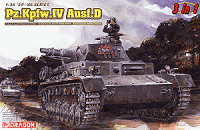











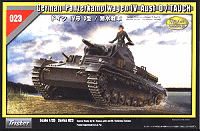










References:
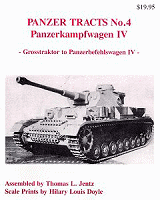 |
Panzer Tracts No.4 Typical Panzer Tracts book with excellent technical descriptions and detailed coverage of the Panzer IV. |
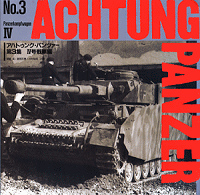 |
Achtung Panzer No.3 Excellent detail coverage of the Panzer IV with the usual detail photos and drawings of all versions of the Panzer IV. |
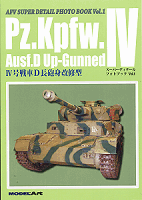 |
Pz.Kpfw.IV
Ausf.D Up-Gunned AFV Super Detail Photo
Book Vol.1 56 pages, full colour, soft cover |
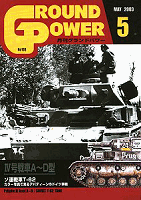 |
Ground Power Magazine PzKpfw IV Ausf.A-D |
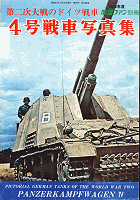 |
Koku Fan World Tank Series Japanese text but 1:35 plans and many wartime Pz.IV photos |
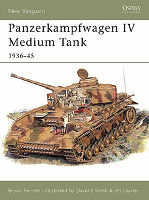 |
Panzerkampfwagen IV Medium Tank 1936-45 Osprey New Vanguard 28 ISBN: 1855328437 |
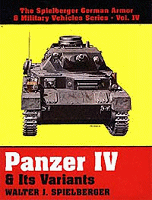 |
Panzer IV & Its Variants Schiffer Publishing |
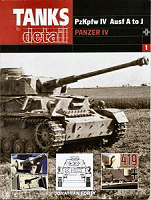 |
PzKpfw IV Ausf.A to J |
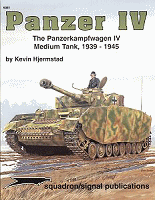 |
PzKpfw IV The usual in action fare with photos and drawings of the Pz.IV
versions. |
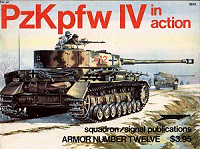 |
PzKpfw IV in action #2012 The usual in action fare with photos and drawings of the Pz.IV versions |
Page created April 25, 2006
Updated October 15, 2006 (Blue text)
Updated January 3, 2007 (Brown text)